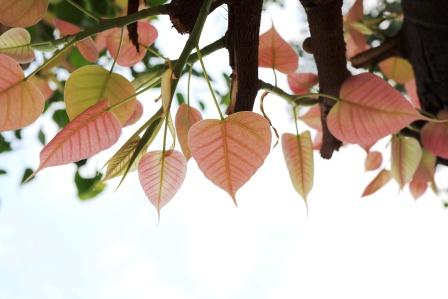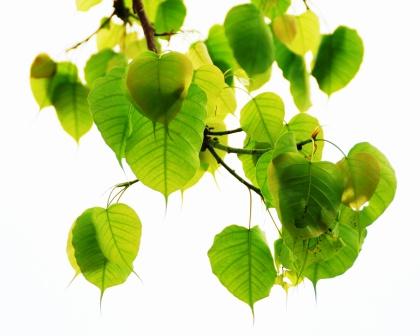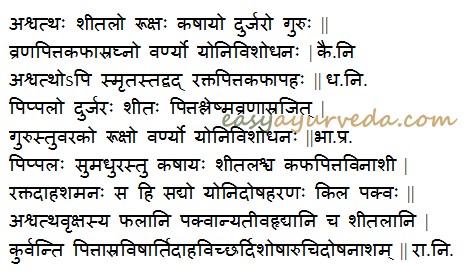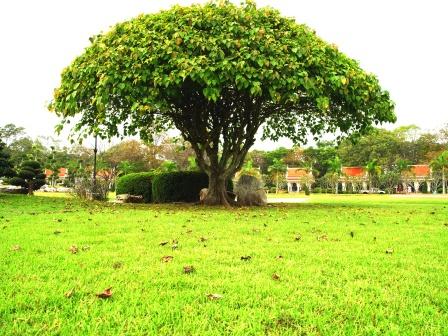Bodhi Tree: Ficus religiosa, Uses, Research, Remedies, Side Effects
Ashwattha (Peepal tree) is a well known religious tree appreciated all over India. Ayurveda uses stem bark, fruits, root, leaf, milk, tender shoots, in various medicines and remedies.
Ashwattha tree is well known for its wound healing, absorbent, memory enhancing and complexion enhancing properties. As per astrology and Hindu philosophy it is useful in infertility cases as well.
Table of Contents
Introduction

Ashwattha- Ficus religiosa is an Ayurvedic tree used for the treatment of cough, skin diseases, improving the skin complexion, nausea, vomiting, diarrhea and improving the sexual potency. It is commonly known by the terms Bodhi tree, Sacred fig, Peepal tree etc.
Latin name- Ficus religiosa Linn.
Family- Moraceae (vata kula)
Ashwattha Home Remedies
For wound wash
1. Peepal stem bark decoction for wound wash:
50 gram peepal stem bark is cooked with 500 ml water till the water reduces to 250 ml. This is used to wash the wounds in lukewarm condition. This is helpful in infected as well as non infected wounds and it facilitates quick healing.
Read related:
For mouth ulcer
2. Bodhi Tree Tender leaf shoot fine paste in mouth ulcer:
5-6 tender shoots of the tree are taken and crushed well to obtain the fine paste. This is retained in the mouth for 5-10 minutes. This helps to relieve stomatitis.
Read related: Mouth Ulcers: Ayurvedic Treatment, Medicines, Remedies, Tips

For wet skin lesions
3. Root bark powder in oozing skin lesions:
The root bark fine powder is used for dusting over the oozing skin lesions to stop secretion.
Same root powder (3-5 gram) can be used to administer internally along with honey for quick wound healing and in skin disorders associated with secretions and oozing.
4. Latex application over the eczema:
Early morning fresh latex is collected and this is applied over the skin lesions. This relieves hyper pigmentation as well as discoloration of the face.
For leucorrhea
5. Fresh latex with milk for leucorrhoea:
2 ml of fresh milk from the tree is added to a cup of milk and taken early in the morning in an empty stomach. This pacifier long persists non specific leucorrhoea by 120 -30 days medication.
Read related: Vaginal White Discharge – Ayurvedic Treatment, Home Remedies
For stammering
6. Ashwattha seed powder chapati prepared over the leaf of Ashwattha in stammering:
1 cup of Ashwattha seeds are collected and fine powder is made.To this equal amount of wheat powder/flour is added and by adding ghee dough is prepared. (Salt should not be added).
This is rolled/pressed into small chapati over the Ashwattha leaf. Along with the leaf this is baked. This is given to the kids who are suffering from stuttering. This has a good effect on such complaints.
*This traditional practice was documented in Tumkur district.
Click to consult Dr MS Krishnamurthy MD (Ayu), PhD
Vernacular names
Names in different languages:
Hindi name- Peepal tree
English name- Sacred fig
Arabic name- Shajratul murthash, darakth-e-larzan, pipal.
Bengali name- Aswattha, Ashud
Gujarathi name- Peepalo
Kannada name- Ashwattha, agaki, alli, arali mara, ashvathamara, attasa, basari, pippali, rangibasari.
Malayalam name- Ashwatham, arachu, aracu, arasu, araval, arsam, devataru, mangalyam, rohi.
Marathi name- Peepal, ashvath, pimpal, pipal.
Tamil name- Ashwatham, arasan, arasha maram, aal, aalvallari, asuvattham, asvattam, attira, attiru, pippalam, tanivirutcham.
Telugu name- Ashwathamu, arasum, ashvaddhamu, ashvattham.
Urdu name – peepal.
English name – bo-tree, peepul, pipal, pipal tree.
Siddha name – Nandukal, Nandukkal

Morphology
Morphology of Ficus religiosa:
Sacred fig is a large tree, growing to a height of 20-25 meters and 2-3 meters in diameter, found all over India. The bark of the tree is pale brownish white, cracked in nature. The leaves are thin, shining, cardiac shaped at the base and elongated at the tip and have 5-7 visible veins. The fruits are small, round, about 0.5 inch in diameter. They are green when unripe and turn to blackish color when ripe. Fruits are seen in the summer season and ripe during the rainy season. People belonging to Hindu and Buddhist religions consider the tree as sacred and hence the tree can be seen planted around the temples.

Properties, part used, dosage
Medicinal properties of Sacred Fig:
Rasa (Taste) – Kashaya (Astringent), Madhura (Sweet)
Guna (Qualities) – Guru (Heavy for digestion), Ruksha (Dry in nature)
Vipaka – Katu (Undergoes Pungent taste after digestion)
Veerya (Potency) – Sheeta (Cold)
Karma (Actions) – Kaphapitta shamaka (reduces vitiated kapha and pitta dosha)
Part used- Bark, Tender leaf, Latex and Fruit
Dosage-
Powder- 3 to 5 g
Decoction- 50 to 100 ml
Chemical composition
The bark of the tree contains beta- sitosterol-D-glucoside, Vit.K, n- octacosanol, methyl oleanolate, lanosterol and stigmasterol. The fruit contains about 5% protein having essential amino acids, isoleucine and phenylalanine.
Sacred Fig leaves contain a high amount of tannic acid. The fruit consists of tyrosine and asparagines in significant amounts. The leaf possesses minerals like iron, copper, calcium, zinc and manganese.The seeds possess threonine, alanine and valine. The leaves contain leucine, isoleucine, methionine, tryptophan, threonine, glycine aspartic acid, serine and arginine. Vitamin K is present in the stem.
Uses
Uses of Ashwattha:
- The tree is useful in the treatment of chronic ulcers, stomatitis, menstrual irregularities, diarrhea, diabetes, epilepsy, and gastric disturbances, infertility and infectious disorders.
- The milky latex obtained from the bark, root or fruit of the plant is given in a dose of 5-6 drops with honey and ghee to treat impotence and help in conceiving in females.
- The decoction of the bark or root of Ficus religiosa is given in a dose of 50-60 ml to treat joint swelling and pain.
- The tender leaves of Ashwattha and Vata (Ficus bengalensis) are made into paste and applied over the skin having black heads, pimples and discoloration to get the original skin tone.
- Latex of Ficus religiosa is applied over wounds and bleeding spots to heal wound and control bleeding respectively.
- Decoction of the bark of the tree is given in a dose of 50-60 ml to control diabetes and treat diseases of the vaginal tract.
- The dried powder of the fruits or the paste of the bark is given with honey or sugar candy to treat severe cough.
- Cold infusion or decoction prepared from the trunk bark or fruit of Ashwattha is consumed in a dose of 50 ml to treat skin diseases and acts like blood purifier.
- In pregnant women, the decoction of the bark of Ficus religiosa helps in strengthening the uterine muscles and retains the fetus till full term.
- Gargling with lukewarm decoction of the bark of Ashwattha is useful to treat mouth ulcers and gingivitis.
- Read related: 6 Ashwattha (Sacred Fig) Remedies: White Discharge, Mouth Ulcer, Eczema
Sanskrit verse

Traditional uses, Indications
Traditional uses of pipal tree:
Sheetala – coolant
Durjara – hard to undergo digestion
Guru – heavy to digest
Varnya – Improves skin tone and complexion
Yonishodhana – cleanses uterus – used in vaginal douche treatment
Indicated in –
Vrana – Ulcers, wounds
Asra – blood disorders such as abscess, skin disorders, bleeding disorders such as menorrhagia, nasal bleeding etc.
Daha – burning sensation, as in gastritis, neuropathy, burning sensation in eyes etc
Visha – Toxic conditions, poisoning
Chardi – Vomiting
Shosha – emaciated
Aruchi – anorexia
The holy fig fruits are wholesome to the human body and can be consumed as food.
It is palatable and is cold in potency.
DoShically, it appeases the pitta in combination with rakta [bleeding diathesis].
Indicated and beneficial in conditions of excessive thirst, vomiting, anorexia. (Ayurveda Mahodadhi)
As per Bhojana Kutuhalam, The fruit of ashvatha is wholesome for the body, acts as a cardio tonic and has cold potency. It treats pitta and rakta vitiated conditions, burning sensations, thirst, vomiting and tastelessness.
Formulations (Yoga)
Aswattha kashaya
Aswattha ksharajala
PAncha valkala lepa
Adverse effects
Peepal tree Adverse effects:
No known adverse effect is known or reported after the normal use of Ashwattha.
People with constipation should take care.
It is a coolant.
Interaction with medicines, supplements
Can this be used while taking Homeopathic medicine?
Yes. This product does not react with homeopathic medicine.
Can this medicine be continued while taking supplements like multivitamin tablets, Omega 3 fatty acids etc?
Yes. Generally, this product goes well with most dietary supplements. However, if you are taking more than one product per day, please consult your doctor for an opinion.
With western
medicines
Seek your
doctor’s advice if you are taking this product along with other western
(allopathic / modern) medicines. Some Ayurvedic herbs can interact with modern
medicine.
If both Ayurvedic and allopathic medicines are advised together, then it is
best to take Allopathic medicine first, wait for 30 minutes and then take the
Ayurvedic medicine.
Ayurvedic medicines
Ayurvedic medicines containing Ashwattha:
Nalpamaradi tailam: It is anayurvedic oil used for the treatment of Herpes, Scabies, Eczema, Dermatitis, allergic skin diseases such as ringworm infestation etc
Arimedadi tailam: It is an ayurvedic oil used for the treatment of oral diseases like gingivitis, bleeding of gums, bad breath etc. The oil is used for gargling purposes.
Sarivadyasava: It is a liquid preparation used for diabetes, diabetic carbuncles and related skin complications, gout, skin infections and in rheumatism.
Panchavalkaladi tailam: It is a herbal oil used externally to treat skin diseases such as eczema and dermatitis.

Dermosooth ointment: It is a proprietary Ayurvedic medicine, useful in the treatment of rheumatoid arthritis, burning sensation and improves the complexion of skin.
Research
Research articles related to Ficus religiosa (Bodhi tree)
Anti- microbial activity: While working on antimicrobial property studies with different solvent extracts of various parts of this tree, recent research articles have been surveyed. Most of the recent reports have used Disc Diffusion, Well Diffusion, MIC (Minimum Inhibitory Concentration) and MBC (Minimum Bacterial Concentration) methods for determination of antimicrobial potential. With all the studies and reports made regarding Ficus religiosa, it can be rightly concluded that the numerous ethno medicinal properties along with the antimicrobial activity which has been proven, shows that this tree has tremendous potential for isolating strong antimicrobial compounds or biomolecules which can be used in the near future area of drug synthesis.
Anti- Parkinson activity: In the present study, we evaluated anti-Parkinson’s activity of petroleum ether extract of Ficus religiosa (PEFRE) leaves in haloperidol and 6 hydroxydopamine (6-OHDA) induced experimental animal models. The experiment was designed by giving haloperidol to induce catalepsy and 6-OHDA to induce Parkinson’s disease-like symptoms. The increased cataleptic scores (induced by haloperidol) were significantly () found to be reduced, with the PEFRE at a dose of 200 and 400 mg/kg (p.o.). 6-OHDA significantly induced motor dysfunction (muscle rigidity and hypolocomotion). 6-OHDA administration showed significant increase in lipid peroxidation level and depleted superoxide dismutase, catalase, and reduced glutathione level.
Anti- diabetic activity: The ethanolic extracts of the leaves and fruits of Ficus religiosa Linn. were comparatively evaluated for their blood glucose lowering activity in normal and alloxan induced diabetic rats. The ethanolic extract of the fruit, at a dosage of 250 mg/kg body weight, was found to exert a more pronounced antidiabetic activity than a 100mg/kg body weight dose.

Anti- ulcer activity: the present work was undertaken to validate the anti-ulcer potential of the ethanol extract of stem bark of F. religiosa against in vivo indomethacin- and cold restraint stress-induced gastric ulcer, and pylorus ligation assays. The extract (100, 200 and 400 mg/kg) significantly (P<0.05) reduced the ulcer index in all assays used. The extract also significantly (P<0.05) and increased the pH of gastric acid while at the same time reduced the volume of gastric juice and free and total acidities.
Sanskrit synonyms
Sanskrit Synonyms of Aswattha:
Gajanana – the leaves resemble the face of Lord Ganesha
Chaladala – leaves always flutter in the tree
Swadubeejaka – sweet tasting seeds
Pavitraka, Mangalya, Shubhada – auspicious
Sevya, Pathya, Shuchidruma, Dharma Vruksha, Achyuta Vasa, Chandrakara, Vipra, Shubhada, Lakshmivan, Keshavavasa – Gods reside in this plant
Gajashana – food for elephants
Yajnika – used in Yajna, Homa
Ksheeradruma, Ksheerapadapa – yield latex
Shyamala Chada – white bark
Bodhidru, Bodhi Vruksha
Chaityadruma, Gruhyapatra,
Pippala, Dharmavruksha
Classical categorization
Charaka Samhita- Mutrasangrahaniya, Kashaya skandha
Sushruta Samhita- Nyagrodhadi gana
Vagbhata- Nyarodhadi gana
Bhavaprakasha- Vatadi varga
Dhanvantari Nighantu- Amradi varga
Kaiyyadeva Nighantu- Oushadhi varga
Raja Nighantu- Amradi varga
Scientific classification
Kingdom: Plantae
Order: Rosales
Family: Moraceae
Genus: Ficus
Species: F. religiosa
Author: Dr.B.K.Prashanth M.D (Ayu), Ph.D
E mail: [email protected]
Click to consult Dr Prashanth BK
Sthanika Karma (Systemic Action)
External Application – Improve complexion, It has Analgesic, wound healing, Anti inflammatory and blood purifying action. Leaf buds can be used for external application to improve complexion. For fast wound healing its bark powder can be used externally on wounds. Its latex is indicated in various inflammatory conditions to reduce pain and arrest bleeding. Decoction of the bark can be used in mouth ulcers, Fistula, inflammatory wounds etc.
Internal administration-
Digestive system – Bark is absorbent in nature. Ripened fruit is sweet in taste, unctuous, and mild purgative in action. Bark decoction indicated in vomiting, diarrhea etc. Fruit can be given in conditions like constipation, abdominal pain etc.
Circulatory System – Fruit and bark is indicated in Bleeding disorders. In vatarakta (Rheumatic complaints) Bark decoction with honey can be given.
Respiratory system – Bark pacifies kapha dosha, indicated in cough. Fruit is beneficial in Asthma conditions.
Reproductive system – Fruit, bark, Root have Aphrodisiac and Garbhasthapana action (helps to retain pregnancy). Fruit powder can be given for garbhasthapana purpose and for Aphrodisiac action its fruit, root, bark or leaf bud can be boiled in milk and administered along with sugar and honey.
Excretory system – reduces urine output. bark decoction and fruit is indicated in diabetes.










6 comments
Ravi
How should it be used to treat “DAHA” ?
Dr J V Hebbar MD(Ayu)Author
Bark decoction is useful to relieve Daha
chinmaya
Is it true that pippal tree gives 24hour oxygen?
Dr J V Hebbar MD(Ayu)Author
Most plants largely uptake Carbon dioxide (CO{-2})and release oxygen during the day (photosynthesis) and uptake oxygen and release CO{-2} during the night (respiration). Some plants such as Peepal tree can uptake CO{-2} during the night as well because of their ability to perform a type of photosynthesis called Crassulacean Acid Metabolism (CAM).
However, it is not true that they release large amounts of oxygen during the night. But it absorbs Co2. Read related-
http://www.thehindu.com/seta/2004/12/30/stories/2004123000231700.htm
Anil
Is bargad ka doodh in powder form available in a pack by vita company is good for health
Anil
Is Behring raja churna is good for hairs as my hair are going white